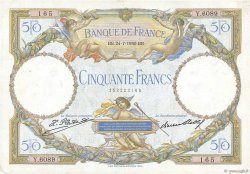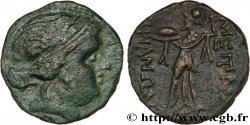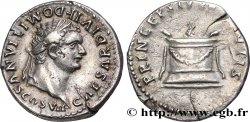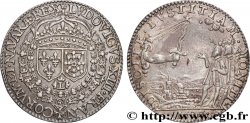fjt_1021456 - LOUIS XIII THE JUST Imposition de la loi commune (l’édit de Nantes) en Béarn 1620
500.00 €(Approx. 585.00$ | 435.00£)
Quantity
Add to your cart

Type : Imposition de la loi commune (l’édit de Nantes) en Béarn
Date: 1620
Mint name / Town : Paris
Metal : silver
Diameter : 27 mm
Orientation dies : 6 h.
Weight : 4,51 g.
Edge : lisse
Puncheon : sans poinçon
Rarity : R1
Coments on the condition:
Superbe patine grise hétérogène, présentant une petite usure sur certains hauts reliefs. Traces d’un ancien nettoyage
Obverse
Obverse legend : * LVDOVICVS. XIII. D. G. FRAN - CORVM. ET. NAVARÆ. REX.
Obverse description : Écu accolé de France et de Navarre sous une couronne, le chiffre du roi entre trois couronnes sous les écus, le tout entouré des colliers de l'ordre de Saint-Michel et du Saint-Esprit.
Obverse translation : (Louis XIII, par la grâce de Dieu, Roi des Francs et de Navarre).
Reverse
Reverse legend : DISCITE. IVSTITIAM. MONITI.
Reverse description : En face d’un groupe d’hommes regardant à gauche, un bras sortant d’un nuage et tenant une épée flamboyante, au-dessus de laquelle brille une étoile ; au second plan, une ville, avec des montagnes dans le lointain ; à l’exergue : .1620..
Reverse translation : (Apprenez la justice de celui qui en est éclairé).
Commentary
Les protestants du Béarn avaient refusé d’appliquer l’édit de Nantes. En 1620, le jeune roi décide, seul et contre l’avis de son Conseil, de faire respecter l’édit en Béarn. Il quitte Poitiers en septembre à la tête de son armée qui doit mettre le siège aux places fortes du Béarn. Le 15 octobre, le roi entre à Pau et reçoit l’allégeance des Béarnais, le catholicisme est rétabli et les biens du clergé confisqués par les Protestants reviennent à leurs propriétaires légitimes. La légende de revers et le motif se rattachent probablement à cet épisode, la ville du revers pourrait symboliser Pau et le Béarn, les montagnes sont les Pyrénées.
The Protestants of Béarn had refused to apply the Edict of Nantes. In 1620, the young king decided, alone and against the advice of his Council, to enforce the edict in Béarn. He left Poitiers in September at the head of his army, which was to lay siege to the strongholds of Béarn. On October 15, the king entered Pau and received the allegiance of the Béarnese, Catholicism was restored, and the clergy's property confiscated by the Protestants returned to its rightful owners. The reverse legend and the motif are probably linked to this episode; the city on the reverse could symbolize Pau and Béarn, and the mountains are the Pyrenees.
The Protestants of Béarn had refused to apply the Edict of Nantes. In 1620, the young king decided, alone and against the advice of his Council, to enforce the edict in Béarn. He left Poitiers in September at the head of his army, which was to lay siege to the strongholds of Béarn. On October 15, the king entered Pau and received the allegiance of the Béarnese, Catholicism was restored, and the clergy's property confiscated by the Protestants returned to its rightful owners. The reverse legend and the motif are probably linked to this episode; the city on the reverse could symbolize Pau and Béarn, and the mountains are the Pyrenees.








 Report a mistake
Report a mistake Print the page
Print the page Share my selection
Share my selection Ask a question
Ask a question Consign / sell
Consign / sell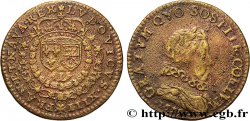
 Full data
Full data




